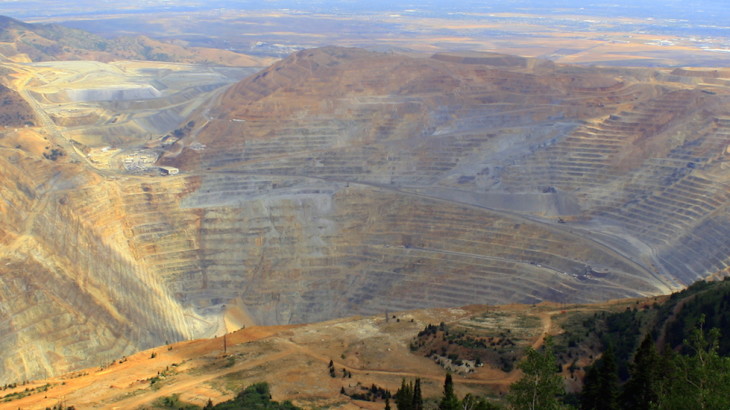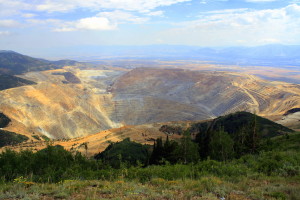This is an excerpt from an early draft of a forthcoming book about how “green technology” and “renewable energy” will not save the planet.
One of the largest copper mines in the world is the Kennecott Bingham Canyon Mine, which is just outside Salt Lake City in the Oquirrh Mountains. Flying into the city, you can see the mine from a long way off: a 2.5 mile wide pit dug more than half a mile into the root of the mountains.
At the Kennecott Mine, explosives are used to break up the rock, which is then loaded onto 2-story tall dump trucks which put the material on a 5-mile conveyor belt that carries it to a nearby facility. Here, the rock is ground to dust by rotating crushers, then added to a slurry of water and chemicals like methylisobutyl carbinol, potassium and/or sodium ethyl xanthate (which has sickened many workers and is “especially toxic to aquatic life”), or various dithiophosphates and dithiocarbamates. This process, called “flotation,” separates the valuable minerals out. Next, the slurry is sent through a pipeline 17 miles to the smelter in Magna, Utah, where it is dried and injected into a superheated furnace to oxidize iron and sulfur. The sulfur reacts with oxygen to form sulfur dioxide gas, which is captured and used to produce sulfuric acid. The iron oxide is skimmed off. The copper sulfide material that is left behind is about 70% pure, and goes through a further smelting process and then another electrolysis process to reach 99.99% purity.
Over more than 100 years of operation, the impacts of the Kennecott Mine are too numerous to mention. These impacts include acid rain from smelter emissions, asbestos-related illness in workers, emissions of arsenic and mercury, more than 200 million gallons of highly contaminated process water released into the aquifer (where it has seeped into the nearby Jordan River and contaminated groundwater along a 72-mile plume), a tailings pond containing more than 1 billion tons of toxic material (incidentally, Kennecott worked with state regulators to hide the potential danger of the dam on this tailings pond failing; it would have killed numerous people in Magna, directly below it.AZP They also plan to expand this tailings pond, which would destroy more than 700 acres of wetlands – did we mention the whole thing is directly adjacent to the Great Salt Lake, “one of the Western Hemisphere’s most significant migratory bird habitats”?), acid-mine drainage, severe dust pollution that has caused substantial risk of health issues for nearby residents, releases of toxins like copper sulphate, selenium releases that killed more than 30% of the fish in the Jordan River, and more. Between 2000 and 2011, there were 18 documented spills and leaks related to the mine, which in total released more than 8 million gallons of contaminated water/tailings and more than 260,000 tons of concentrate and metals. In 2008 the Fish and Wildlife Service sued the mine for release of selenium, copper, arsenic, zinc, lead, and cadmium.
The land affected by the mine is important. The Oquirrh Mountains, the Salt Lake Valley, and the area around Great Salt Lake are located where the Great Basin meets the Colorado Plateau; the intersection of two great ecosystems leads to a flourishing of life. The mountains rise to 10,000 feet above the south end of the Salt Lake, and a huge variety of habitats can be found in this small region, from exposed alpine tundra to sagebrush and rabbitbrush steppe. Springs feed Aspen and maple forests on the cool north-facing slopes. Juniper and Piñon Pine live on the western and southern slopes. Salt tolerant wetland plants and scrub that can survive both wet and parched years thrive near the lake shore. This place is home to mountain lions, Mule deer, butterflies, bald eagles, elk, waterfowl, red-backed voles, shrews, Black bears, mice, American Coots, blackbirds, Great Blue Heron, Yellow Warbler, hummingbirds, hawks, Western Grebe, Hermit Thrush, Mink, Osprey, Ruffled Grouce, Lark Bunting, Hairy Woodpecker, kingfisher, Bonneville cutthroat trout, Redside shiner, Speckled dace, Utah chub, three species of sucker (including the endangered June sucker), and more. Migratory birds visit the area in huge numbers in the spring and fall. Species that have been extirpated from this area include Grizzly bears and wolves. None of these species live on the mountains that no longer exist at the Kennecott mine site, or in the tailings pond, or on the contaminated hillsides around the smelter.
And yet, according to the Kennecott website, “environmental stewardship is at the heart of [their] commitment to sustainable development… Whenever possible, we prevent, or otherwise minimize, mitigate or remediate any potentially harmful effects of our operations on the environment.”
Do you believe they are telling the truth?



Hi! Are there any updates on the Kennecott Mining ending?? I live very close to the mine and it breaks my heart to see the mountains just being torn to shreds. I can’t imagine all of the natural habitats and wildlife they are taking their homes from.
It’s still active, with no signs of shutting down. The company is making billions. We don’t think they will shut down unless they are forced to do so by legal action, legislation, or direct action. That’s our task: to build those movements.
It’s really terrible what mining does to the planet. So much destruction and pollution.